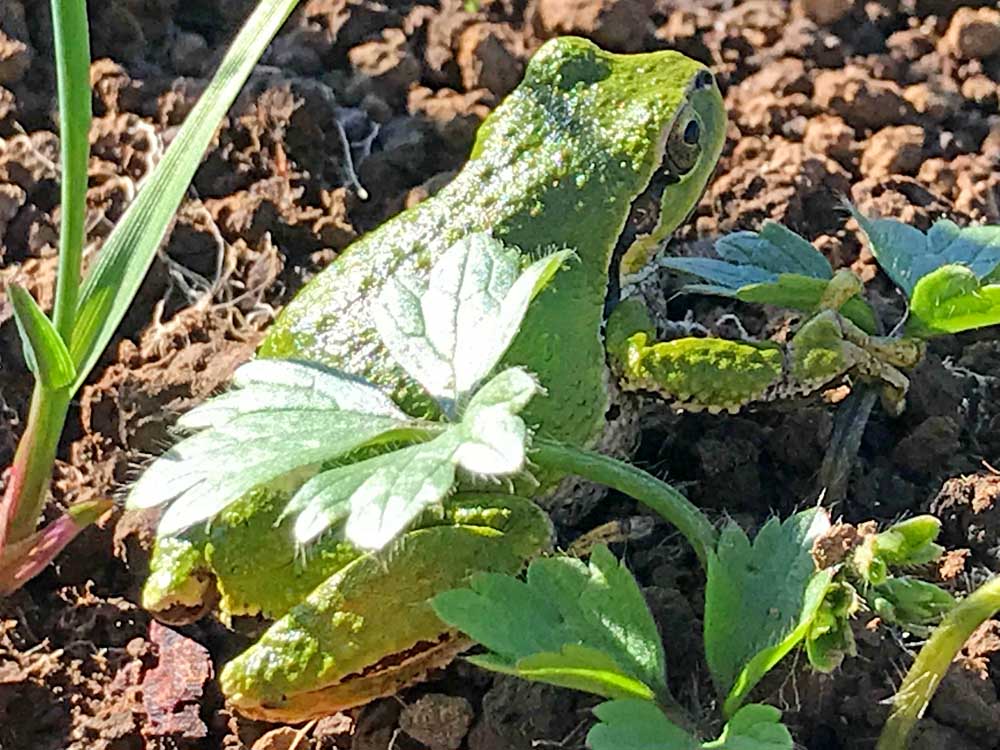Our amazing little ‘Kermit’: The Pacific tree (or chorus) frog
Published 11:19 am Sunday, April 16, 2023

- As can be surmised from their name, Pacific tree frogs aren’t residents of the forest floor — but they spend a lot of time there in their hunts for food and mates. They measure little more than two inches from nose to tail. They are actively singing in Pacific County this April.
It is early spring, and in many fortunate places near ponds, puddles and wetlands across Washington, voices of our small native frog ring all around. The song is both joyous and sometimes deafening! It is a crisp, “ribbit,” with many joining into the occasionally synchronized chorus.
Trending
To hear tree frogs in a marsh in Cape Disappointment State Park: tinyurl.com/Tree-frogs-singing
In spring, male Pseudacris regilla, inflate sacs on their lower jaw, and sing to attract mates around the edges of open water. They defend their tiny singing territories (about 30 square inches, according to one study) and hush when a prospective female arrives. They then quietly mate. Eggs are laid in water and attached to or under vegetation. This remarkable critter is the most widespread frog in the Pacific Northwest, occurring across many habitats and elevations. They are a very adaptable amphibian.
They are small — with adults measuring only 2 or 3 inches in length, and a formidable almost 1 inch tall. They can tolerate a wide range of conditions, including dry forests, and travel to upland sites when not breeding. Tree frogs, like all frogs, undergo the miracle of metamorphosis, whereby the herbivorous, swimming tadpole, changes into a carnivorous, legged predatory adult frog. They can live five or more years!
These little critters are voracious predators too, eating a wide variety of insects and various invertebrates (including slugs), usually swallowing their prey whole. They capture prey using their long flashing, sticky tongue and quick strong jaws. They are also prey for a wide variety of predators, including garter snakes, kingfishers, great blue herons and even some owls.
Recognizable by the distinctive black eye stripe, they come in a variety of colors, but mostly either brown gray, or green (sometimes a strikingly bright green!). I heard these frogs change color to match their environment, so I reached out to my friend, Dr. Corey Straub, who studied them for his Master’s Thesis, and asked. He sent me this wonderful short essay answering the question: Do Pacific tree frogs change color? And how?
‘Pacific Tree Frog Coloration,’ by Dr. Corey Straub
One of the more interesting features of Pacific tree frogs is their body color. In a single population, green, brown, and gray frogs often coexist. In rare cases, reddish and even blue frogs have been observed. Species with color polymorphisms (poly = multiple, morph = form) raise lots of interesting questions for biologists. What is the function of body color? Why does it vary among individuals? Can individuals change their body color?
Body color can serve multiple functions, but the one that has received the most attention in Pacific tree frogs is protection from predators. Cryptically colored (or camouflaged) frogs are harder to see, and studies have shown that Pacific tree frogs are less likely to be eaten by snakes and birds when they are resting on a background that matches their body color. In nature, green, brown and gray backgrounds are provided by leaves, soil and tree bark. While all three colors can be found in the same habitat, seasonal changes in the amount of green vegetation are a regular feature of the frogs’ environment. The frogs emerge from their overwintering refuges to find a largely gray and brown world that becomes increasingly green as spring unfolds into summer. Researchers have observed that the relative abundance of green color morphs increases with the abundance of green vegetation, and vice versa. Thus, hungry predators and variation in environmental color (across space and time) appear to work together to favor color polymorphism in the Pacific tree frog.
Interestingly, the Pacific tree frog has two different strategies for blending in. Some frogs change their body color, while others are careful about where they rest. Color-changers will turn green (or stay that way) in response to brighter environments, perhaps because bright light and green leaves are associated in nature. The change from one color morph to another takes days-to-weeks (a rate that true chameleons would consider laughable) and only some individuals are capable of it. Non-changing green and brown frogs appear to compensate for their stubborn skin by choosing the right place to rest. These frogs select backgrounds that match their body color when given a choice, an adaptive behavior that their color-changing counterparts seem to lack.
We find tree frogs under the barbeque cover and in potted plants on our porch in the dry Methow Valley every year! Where do they winter? According to the Deschutes Land Trust, they “seek out deep cracks and crevices in logs or rocks, or burrow as deep as they can in leaf litter” to hibernate. And they will move long distances to find good habitats.
According to one source, Pacific tree frogs were one of the only vertebrate species to survive in the Mt. Saint Helen’s blast zone!
Numbers of amphibians globally are declining and of great concern. However, our little frog seems to be doing okay, and we get to enjoy their singing and delightful presence on our small forest lands! What a cool little critter. Appreciate the next one you meet.









